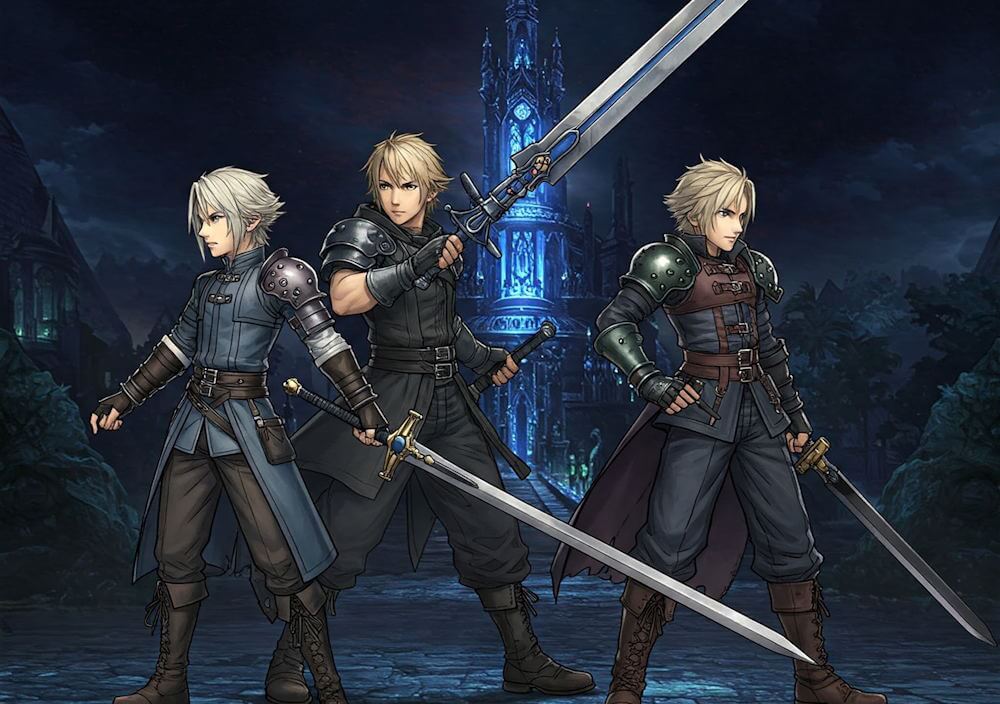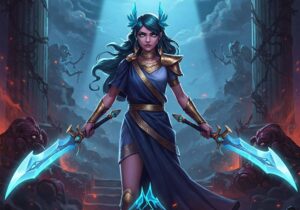The Final Fantasy franchise has long been recognized for its innovative approach in developing combat systems that reflect evolving gameplay paradigms. With a history spanning several decades, each installment has introduced unique mechanics that resonate with the themes and narratives of their respective stories. The combat systems of both Final Fantasy XVI (FFXVI) and Final Fantasy VII Remake (FFVII Remake) exemplify this evolution, showcasing different interpretations of engagement and strategy that contribute to the player experience.
Final Fantasy VII Remake, which re-imagines the iconic 1997 title, employs a hybrid combat system that blends real-time action with strategic commands. Players can switch between characters while actively engaging in combat, allowing for a dynamic yet tactical approach. The strategy central to this system is further emphasized through the Active Time Battle (ATB) gauge, which enables players to unleash powerful abilities and spells, thereby encouraging thoughtful resource management during intense encounters. This system effectively bridges the gap between traditional turn-based mechanics and modern action-oriented gameplay, appealing to both veteran fans and newcomers alike.
In contrast, Final Fantasy XVI embraces a more action-driven combat approach that offers fluidity and adrenaline-pumping encounters. The game emphasizes character abilities and combos, allowing players to engage in combat with an emphasis on timing and precision. This system is designed to immerse players deeper into the narrative, with battles that are visually spectacular and narratively relevant. The combat mechanics in FFXVI promote a sense of empowerment and prowess, inviting players to experiment with different playstyles while engaging with its richly woven storyline.
Understanding the historical context and evolution of these combat systems serves as a foundation for comparing how they influence gameplay and overall player satisfaction. As the franchise continues to evolve, the distinct approaches seen in FFXVI and FFVII Remake highlight the innovation and creativity that characterize the series.
Overview of FFXVI Combat Mechanics
The combat mechanics in Final Fantasy XVI (FFXVI) represent a significant evolution from its predecessors, embracing a fast-paced, action-oriented style that resonates with modern gaming standards. Central to the gameplay experience are the character abilities, which allow players to unleash a variety of attacks and magical skills. These abilities can be tailored to individual playstyles, providing a personalized approach to combat that enhances player engagement and immersion.
FFXVI employs a real-time combat system that requires players to be more strategic and responsive than ever before. Unlike the turn-based mechanics of earlier titles, the real-time system promotes swift decision-making and quick reflexes. This aspect of combat is characterized by a smooth flow, with players capable of chaining together light and heavy attacks to create combos that deal significant damage to foes. Each character’s weapon provides distinct advantages, offering varied approaches to confrontations.
The game also integrates a sophisticated job system, allowing characters to switch between different roles and access unique abilities associated with each job. This dynamism not only enriches the combat mechanics but also encourages experimentation, as players can explore combinations of jobs to discover the most effective strategies against enemies. Moreover, the evade system adds another layer of depth by enabling characters to dodge attacks and reposition themselves in the heat of battle. This mechanic is crucial for both offense and defense, as it can determine the outcome of a skirmish.
Stagger mechanics further heighten the intensity of combat by introducing a system whereby certain enemy attacks can be countered or exploited to create openings for devastating strikes. Additionally, special abilities unique to each character can turn the tide of battle, serving as powerful tools that can be unleashed at critical moments. Overall, FFXVI delivers an engaging combat experience that emphasizes fluidity, offering players a modern interpretation of the beloved franchise’s long-standing combat traditions.
Overview of FFVII Remake Combat Mechanics
The combat mechanics in Final Fantasy VII Remake signify a groundbreaking evolution in the series, merging real-time action with strategic elements to create a unique gameplay experience. At the heart of this system lies the Active Time Battle (ATB) meter, which plays a crucial role in how players engage with enemies. During combat, the ATB gauge fills up through physical attacks or by taking damage, allowing players to execute special abilities, use items, or cast spells. This dynamic mechanism promotes a balanced blend of aggressive and tactical gameplay, compelling players to strike a balance between action and strategy.
Character switching is another prominent feature that enhances the tactical depth of battles. Players have the ability to switch between characters seamlessly, each boasting unique skills, strengths, and weaknesses. This feature enables players to actively adapt their combat strategies to suit various scenarios, whether it involves unleashing powerful spells as Aerith or dealing heavy blows with Cloud’s sword. Such flexibility is especially vital when confronting diverse enemies, as successful navigation of their attack patterns often requires a comprehensive understanding of each character’s capabilities.
Moreover, players can utilize both physical and magical attacks, further diversifying their strategic options during combat. Each character has access to an array of abilities and spells, which can be tailored to exploit enemy weaknesses. Planning attacks and timing is paramount; players must consider when to unleash their abilities for maximum effect. This combination of real-time action, character diversity, and strategic planning results in a combat system that feels engaging and rewarding. Overall, the combat mechanics in Final Fantasy VII Remake intricately intertwine strategy and action, fostering a rich battlefield experience that encourages both creativity and thoughtful decision-making in each encounter.
Narrative Integration in Combat
The integration of narrative and combat in both Final Fantasy XVI (FFXVI) and Final Fantasy VII Remake (FFVII Remake) showcases distinct approaches that contribute to the player’s overall experience. In FFXVI, the battles are intricately woven into the storyline, reflecting the game’s dark and mature themes. Fighters, such as Clive Rosfield, are often faced with morally ambiguous choices that resonate through their combat encounters. As such, battles become more than mere gameplay mechanics; they serve as significant narrative moments that push character development and the story’s progression forward. The cinematic sequences during pivotal fights further enhance this narrative integration, allowing the emotional weight of the conflict to resonate with players upon each encounter.
Conversely, FFVII Remake presents its combat system as an evolving mechanism that underscores character relationships and persona growth, particularly through the interactions between its iconic cast. The dynamic and fast-paced action allows players to experience the personal stakes through real-time combat, as characters react to one another, revealing deeper emotional contexts. For example, the close quips between Cloud and his allies during combat not only provide insights into their camaraderie but also highlight individual character arcs as they confront and resolve their internal struggles together. This connection between combat and narrative allows players to forge a stronger emotional bond with each character, thus emphasizing relational development throughout the game.
Both games utilize combat as a narrative device, yet they cater to different emotional experiences. FFXVI leans heavily on an overarching story where action and consequence intertwine seamlessly, while FFVII Remake focuses on interpersonal dynamics amid fast-paced skirmishes. Each game captures the essence of storytelling through their respective combat systems, ultimately enhancing player engagement and emotional involvement with their narratives. This comparative analysis underscores the effectiveness of narrative integration in shaping how players experience combat, extending beyond simple gameplay to evoke a deeper connection to the underlying stories.
Visual and Audio Presentation in Combat
When considering combat in video games, particularly in titles such as FFXVI and FFVII Remake, visual and auditory elements play a pivotal role in shaping the overall experience. The graphics in both games demonstrate significant advancements, with FFXVI showcasing a richly detailed environment filled with dynamic lighting and expansive landscapes that elevate the immersive quality of its battles. Character models are meticulously designed, featuring intricate details that make each character feel unique and memorable. The realism in animations, from the fluidity of the character movements to the spectacular execution of special abilities, amplifies the thrill of combat encounters.
In contrast, FFVII Remake leans into its anime-inspired aesthetic while presenting a stunningly modernized interpretation of the original game. The game’s visual fidelity is impressive, drawing players into an evocative world filled with vibrant colors and striking character designs. The combat animations in FFVII Remake highlight the ferocity of battles through hyper-stylized movement sequences. Players observe how each hit feels weighty and impactful, thanks in part to the meticulous attention given to visual effects that provide feedback for every action taken during combat.
Auditory elements are equally essential in crafting an engaging experience. FFXVI features a sweeping orchestral score that intensifies the emotional stakes during battles, matching the gravity of the conflicts with its powerful compositions. Sound design, from the clashing of swords to the roar of spells being cast, integrates seamlessly with the visuals, creating a cohesive combat atmosphere. On the other hand, FFVII Remake employs a modern remix of the original soundtrack alongside new compositions that evoke nostalgia while immersing players in the present combat experience. The auditory presentation in both games enriches the sensation of realism, making every battle feel epic.
Ultimately, the visual and audio presentations in both FFXVI and FFVII Remake greatly enhance the combat mechanics, allowing players to feel truly engaged in their respective worlds.
Difficulty and Challenge Levels
The combat systems in both FFXVI and FFVII Remake provide unique challenges that cater to varying player abilities and preferences. FFXVI introduces a robust difficulty setting that gives players the opportunity to tailor their combat experience to their skill level. Players can select from multiple settings, ranging from easy for newcomers to the series, to hard for those seeking intense competition. This flexibility ensures that the game can appeal to a wider audience, allowing them to enjoy the action without feeling overwhelmed or bored.
In contrast, FFVII Remake also offers multiple difficulty options, but it emphasizes not just sheer challenge but also strategic depth. Its AI design presents a formidable challenge that necessitates careful observation and tactical decision-making. The various encounters, especially during key boss fights, require players to be adaptable. Each boss has unique mechanics and patterns that players must learn in order to prevail, which enhances the combat experience. This design rewards both skillful execution and well-thought-out strategy, providing a fulfilling challenge for those willing to invest time and effort.
Furthermore, accessibility is a vital aspect considered by both titles. FFXVI, for instance, includes several assistive features, such as simplified controls and auto-targeting, to level the playing field for less experienced players. Similarly, FFVII Remake provides a classic mode that enables players to enjoy gameplay without the need to manage complex mechanics. This allows beginners to immerse themselves in the narrative without feeling alienated by the challenging combat systems.
Ultimately, each game presents its own distinct challenges, crafted to engage players of various skill levels. Whether one prefers the flexibility of FFXVI or the strategic depth of FFVII Remake is dependent on individual preference, making both games appeal to different kinds of players seeking a rewarding combat experience.
Player Feedback and Community Opinions
In assessing the combat systems of FFXVI and FFVII Remake, player feedback and community opinions serve as invaluable resources that reflect the diverse experiences and preferences within the gaming community. A significant number of players have taken to various forums and social media platforms to share their insights, with a palpable division emerging between the two titles. FFXVI has been praised for its real-time combat system that blends high-octane action with a rich narrative backdrop. This shift towards a more dynamic engagement has resonated particularly well with players who appreciate the immediacy and visceral nature of battles. Many players have noted the fluidity of character movements and the strategic layering of abilities, which keeps encounters fresh and engaging.
Conversely, FFVII Remake has garnered admiration for its hybrid combat system, combining real-time action with tactical pauses that allow players to strategize mid-battle. This unique approach has captured the hearts of those who enjoy a more methodical style of play, where timing and precision play a crucial role. Many fans reminisce about the original FFVII and feel that the remake beautifully captures the essence of its predecessor while adding modern mechanics. User reviews often highlight the immersive combat feel and how character-specific abilities enhance the overall experience.
The contrast in player opinions typically stems from their gaming backgrounds and personal preferences. Those seeking fast-paced action may lean more towards FFXVI, while others who value tactical depth might prefer FFVII Remake’s slower, more thoughtful approach. This divide is further fueled by differing expectations shaped by each game’s history. Both titles offer unique combat experiences that resonate with distinct segments of the gaming community, ultimately showcasing the richness and variety within modern gaming narratives.
Personal Experience: A Player’s Journey
The journey through both Final Fantasy XVI (FFXVI) and Final Fantasy VII Remake (FFVII Remake) offers a plethora of experiences that highlight the distinct approaches these two titles take toward combat. As an avid player of both, I found myself drawn to the nuances of each combat system, offering unique thrills that shaped my gaming experience.
In starting with FFVII Remake, I was immediately captivated by the blend of real-time and turn-based elements. The Active Time Battle system felt familiar yet fresh, making each encounter a tactical endeavor. I enjoyed the strategy of pausing combat to execute commands, allowing me to meticulously plan my attacks. The characters’ abilities felt fluid, and the combination of roles, like Cloud’s prowess in melee and Barret’s ranged capabilities, created a dynamic team synergy. Navigating through Midgar, each battle felt intense, heightening my engagement with the story and its characters.
Conversely, when I transitioned to FFXVI, the shift to a more action-oriented combat system was palpable. The fast-paced nature of combat demanded quick reflexes and skillful dodging, which sparked an adrenaline rush during encounters. I appreciated how the abilities blended into a seamless flow, allowing for various combos and spectacular animations. However, I found that this fluidity could sometimes sacrifice the strategic depth I enjoyed in FFVII Remake. The emphasis on agility and reaction over planning afforded a different satisfaction but left me longing for a deeper tactical layer during complex fights.
Throughout both experiences, the character development and immersion in the respective worlds remained pivotal. While FFVII Remake offered deeper story-driven encounters, FFXVI’s exhilarating battles held a magnetic appeal that made me eager to master its mechanics. Each combat system shaped my gameplay interactions and ultimately influenced my attachment to the characters and narratives within these two iconic titles.
Final Verdict: Which Feels Better?
In evaluating the combat systems of Final Fantasy XVI (FFXVI) and Final Fantasy VII Remake (FFVII Remake), it becomes evident that both games have carved their own niches in the realm of action RPGs. The differences in combat mechanics and execution ultimately shape the player’s experience, leading to diverse preferences among gamers. FFXVI emphasizes a more visceral, real-time combat experience, where players can seamlessly switch between various abilities and engage enemies with fluidity. This combat system is built around a narrative-driven experience, which connects the player emotionally with the storyline and characters. The ability to engage in fast-paced battles with less focus on turn-based strategies offers a breath of fresh air for players seeking immediate gratification.
On the contrary, FFVII Remake pays homage to its roots by blending traditional turn-based mechanics with real-time elements. Here, players can strategize each move with consideration to character abilities, giving a sense of depth that may resonate more with long-time fans of the franchise. This hybrid combat system creates a balance between action and tactical decision-making, catering to a wider audience. However, it does require familiarity with turn-based elements, which may deter newcomers looking for a more straightforward gameplay experience.
Player feedback reveals mixed responses when comparing combat satisfaction, suggesting that personal preferences heavily influence perceptions of what feels better. Some players appreciate FFXVI’s immediacy and responsiveness, while others enjoy the tactical layer offered by FFVII Remake. Ultimately, both games possess strengths and weaknesses, reflecting their respective designs and target audiences. An ideal approach for future iterations would involve blending aspects from each title, enhancing the combat systems by incorporating the depth of FFVII Remake while maintaining the fluidity of FFXVI. Such an evolution could lead to a richer, more satisfying experience for all players.




